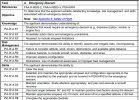DelayedFlight
Filing Flight Plan
- Joined
- Mar 1, 2023
- Messages
- 6
- Display Name
Display name:
DelayedFlight
Hi Folks, I have a couple of questions regarding the Emergency descent on the Check ride. I just wanted to get the consensus and see what comes of it. When the scenario arises on the check ride to perform the emergency descent, do you immediately bank, pitch for airspeed/descent and while descending perform your A-B-C-D-E (checklists and flows), or perform your checklist/flows for the given "problem" and then pitch and bank for your descent?
For example C172 engine fire.
Begin descent and then initiate A-B-C-D-E; turn off fuel, mixture, pump, etc while plummeting toward the earth, or run the checklists FIRST and once complete begin the bank/descent?
What does a DPE like to see, generally?
TIA
For example C172 engine fire.
Begin descent and then initiate A-B-C-D-E; turn off fuel, mixture, pump, etc while plummeting toward the earth, or run the checklists FIRST and once complete begin the bank/descent?
What does a DPE like to see, generally?
TIA





